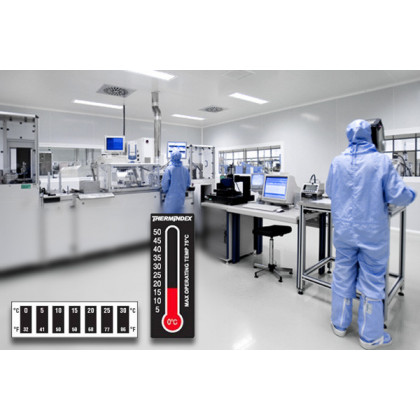Learning about cleanrooms and their regulations is important in order to meet the required conditions inside these rooms. Several aspects come into play.Temperature, air quality, design or contamination that may affect the room are some of the most important. This type of enclosure is normally used in the pharmaceutical, nuclear, microelectronic and food industries.
Its primary function is to guarantee a safe environment in terms of contamination, microorganisms and particles, allowing operations or procedures to be carried out with products and protecting them from contamination.
Progressively, requirements concerning environmental quality, air quality control, and environmental factors, have evolved. This is why factors such as temperature, pressure and humidity are of great importance within the regulations. Below, we specify the current standards and see how adhesive thermometers can help with temperature control inside cleanrooms.
ISO 14644 standard for cleanrooms
A cleanroom is specially designed to maintain low contamination levels. This is why it is key to comply with extremely strict environmental parameters. Processes or operations performed inside them with food or pharmaceutical products, for example, must be carried out safely. The ISO 14644 standard sets out twelve essential points for compliance.
Cleanliness, testing and construction
Part one classifies air cleanliness according to the concentration of particles, in addition to setting out the monitoring guidelines that must be followed to control these established parameters. Parts two and three deal with both testing specifications and testing methods. Part four focuses on essential aspects such as the design, construction and implementation of the cleanroom, always considering its final objective.
Operation, separation and contamination
As for proper operation, part five establishes how it should be done in each case, while part six covers vocabulary. Part seven includes information on separative devices inside the cleanroom. Finally, parts eight and onwards gather the requirements for the most complicated matters. These are molecular contamination of the environment and surface cleanliness by chemical concentration, as well as classifications in terms of cleanliness and concentration of nanoparticles.
Overview and uses of cleanrooms
Basically, the ISO 14644 standard establishes the limits and procedures to achieve the limitation and exclusion of microbes, particles and to eliminate external and internal contamination, which would be that between products.
The use of this type of installation is found in many sectors, such as the pharmaceutical, health, aerospace and microtechnology sectors, as well as in research laboratories and universities. However, some of the most common are operating theatres and cleanrooms in the food industry, which are of vital importance to health.
Cleanroom temperature control labels
In the food industry, the temperature inside cleanrooms must be ideal for the successful completion of the food production process without altering the food’s components. These rooms must be free of microbial and bacterial contamination to prevent public health issues. The same applies to medicines and antibiotics, which must be kept at a specific temperature so that they do not lose their properties or become unsuitable for humans.
One of the most effective methods to control these parameters is the use of adhesive temperature labels, which measure the temperature just like a thermometer. These indicators come in different formats and have different levels. They are quite easy to use. Just stick them on to the area to be controlled and they will display the temperature. This is a convenient, cost-effective solution. Additionally, these temperature indicators do not contain disruptive materials like mercury, batteries or liquids, so using them in this type of installation is not a problem.
In some cleanroom operations, it may be necessary to make sure that a specific temperature is not exceeded. In these cases, the temperature labels for cold chain control
offer a simple solution to the problem. Since these labels permanently change colour, they can guarantee the conditions that have prevailed in the enclosure. This is especially useful for food or pharmaceutical products.
In short, this is what we have to say about cleanrooms and the regulations for everything to run in perfect conditions. All industries are recommended not to spare any expenses when it comes to meeting these requirements.

